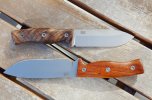My 93 Cocobolo Ram had developed an ugly haze that was bothering me a lot. I knew cocobolo darkens with age but this haze was really ugly.
I did subject the knife to some abuse, mainly plenty of acidic food juices of every kind. Then, in my efforts to protect the wood I would periodically slap whatever wax, furniture polish, oils to try to remove the haze ( I even accidentally used a mineral oil that now I think I had mix with a bit of turpentine 10 years ago and forgot to label the bottle

)
Anyways, today i could not take it anymore and this thread was PERFECT TY

Here is what I did:
Cleaned the grime on the wood with alcohol
Sanded the wood starting at 180 all the way to 2000 (cleaned and removed all sanding residue with alcohol between grit 180 and 600 )
At 600 grit at started wet sanding the wood using a special oil/wax mix that I use for my bowl turning ( walnut oil,bees and emulsified carnauba wax).
Rubbed the wood with 0000 steel wool and the oil/wax.
Buffed the wood with soft buffing wheels designed for wood turning making sure not to touch the metal as it would discolor my wheels. ( tripoli compound, then white diamond then finally carnauba wax)
I am beyond excited !!! The pores seem much smaller too now.
Here are some before and after pics:
Before:
AFTER 














